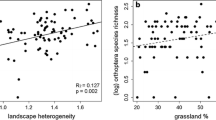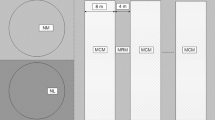Abstract
Alpine landscapes are heavily influenced by ski run management, which can have severe impacts on alpine biodiversity. To assess these impacts on alpine Orthoptera, we compared species richness and species abundance in 41 plot pairs on ski runs and adjacent off-slope control plots in three ski resorts in Austria and Germany. A mixed modelling approach was used to assess the impacts of ski run preparation, artificial snow-making and environmental variables such as altitude, cover of dwarf shrubs and the application of fertilizer. Ski run plots showed a significantly lower species richness and number of individuals than control plots. Moreover, artificial snow led to a further decrease in species number. Hierarchical variance partitioning revealed that Orthoptera community composition is best predicted by environmental variables indirectly related to ski run management (fertilization, cover of dwarf shrubs) and to altitude. Only one out of five species significantly decreased in abundance after artificial snow-making. Other species were more sensitive to fertilizing and altitude. Dwarf shrubs were negatively associated with ski run management but positively associated with abundance of three species and species richness. Our data provide evidence for both direct and indirect consequences of ski runs and artificial snow-making on alpine Orthoptera. Overall, Orthoptera communities are suitable indicators for human-induced changes in alpine environments. In particular, a shift towards generalist species such as Chorthippus parallelus along with a decrease in typical alpine species gives cause for concern as this implies a homogenisation of biodiversity owing to ski run management.


Similar content being viewed by others
References
Abegg B, König U, Bürki R et al (1997) Climate impact assessment im tourismus. Die Erde 128:105–116
Andersen AN, Ludwig JA, Lowe LM et al (2001) Grasshopper biodiversity and bioindicators in Australian tropical savannas: responses to disturbance in Kakadu National Park. Austral Ecol 26:213–222
Auer I, Heim H, Werner R (2001) Niederschlag und Gewitter. In: Amt der Vorarlberger Landesregierung (ed) Klima von Vorarlberg II. Amt der Vorarlberger Landesregierung, Bregenz
Baldi A, Kisbenedek T (1997) Orthopteran assemblages as indicators of grassland naturalness in Hungary. Agric Ecosyst Environ 66:121–129
Baur B, Baur H, Roesti C et al (2006) Die Heuschrecken der Schweiz. Haupt Verlag, Bern
Bayfield NG (1996) Long-term changes in colonization of bulldozed ski pistes at Cairn Gorm, Scotland. J Appl Ecol 33:1359–1365
Bellmann H (2006) Der Kosmos Heuschreckenführer. Franckh-Kosmos Verlags-GmbH & Co KG, Stuttgart
Blick T (1994) Spinnen (Arachnida: Araneae) als Indikatoren für die Skibelastung von Almflächen. Verhand Ges Ökol 23:251–262
Böhm R, Heim H, Werner R (2001) Lufttemperatur/Bodentemperatur/Wassertemperatur. In: Amt der Vorarlberger Landesregierung (ed) Klima von Vorarlberg I. Amt der Vorarlberger Landesregierung, Bregenz
Borcard D, Legendre P, Drapeau P (1992) Partialling out the spatial component of ecological variation. Ecology 73:1045–1055
Braun-Blanquet J (1964) Pflanzensoziologie: Grundzüge der Vegetationskunde, 2nd edn. Springer, Vienna
Cernusca A, Angerer H, Newesely C et al (1990) Auswirkungen von Kunstschnee: eine Kausalanalyse der Belastungsfaktoren. Verh Ges Ökol 19:746–757
Crawley MJ (2005) Statistics: an introduction using R. John Wiley & Sons Ltd, Chichester
Delgado R, Sánchez-Maranón M, Martín-García JM et al (2007) Impact of ski pistes on soil properties: a case study from a mountainous area in the Mediterranean region. Soil Use Manage 23:269–277
Detzel P (1992) Heuschrecken als Hilfsmittel in der Landschaftsökologie. In: Trautner J (ed) Arten- und Biotopschutz in der Planung: Methodische Standards zur Erfassung von Tierartengruppen. J. Margraf, Weikersheim
Detzel P (1998) Die Heuschrecken Baden-Württembergs. Verlag Eugen Ulmer, Stuttgart
Dray S, Dufour AB (2007) The ade4 package: implementing the duality diagram for ecologists. J Stat Softw 22:1–20
Elsaesser H, Messerli P (2001) The vulnerability of the snow industry in the Swiss Alps. Mountain Res Develop 21:335–339
Fattorini M (2001) Establishment of transplants on machine-graded ski runs above timberline in the Swiss Alps. Restor Ecol 9:119–126
Fischer FP, Schulz U, Schubert H et al (1997) Quantitative assessment of grassland quality: acoustic determination of population sizes of orthopteran indicator species. Ecol Appl 7:909–920
Franzke A, Unsicker SB, Specht J et al (2010) Being a generalist herbivore in a diverse world: how do diets from different grasslands influence food plant selection and fitness of the grasshopper Chorthippus parallelus? Ecol Entom 35:126–138
Geiger R (1966) The climate near the ground. Harvard University Press, Cambridge
Geneletti D (2008) Impact assessment of proposed ski areas: a GIS approach integrating biological, physical and landscape indicators. Environ Impact Assess Rev 28:116–130
Hammelbacher K, Mühlenberg M (1986) Laufkäfer- (Carabidae) und Weberknechtarten (Opiliones) als Bioindikatoren für die Skibelastung auf Almflächen. Natur Landschaft 61:463–466
Harz K (1957) Die Geradflügler Mitteleuropas. VEB Gustav Fischer Verlag, Jena
Haslett J (1988) Qualitätsbeurteilung alpiner Habitate: Schwebfliegen (Diptera: Syrphidae) als Bioindikatoren für Auswirkungen des intensiven Skibetriebes auf alpinen Wiesen in Österreich. Zool Anzeiger 220:179–184
Holaus K, Partl C (1994) Beschneiung von Dauergrünland–Auswirkungen auf Pflanzenbestand, Massenbildung und Bodenstruktur. Verh Ges Ökol 23:269–276
Illich IP, Haslett J (1994) Responses of assemblages of Orthoptera to management and use of ski slopes on upper sub-alpine meadows in the Austrian Alps. Oecologia 97:470–474
Illich IP, Winding N (1989) Aut- und Synökologie der Feldheuschrecken (Acrididae: Orthoptera) einer subalpinen/alpinen Almweide (Gasteinertal, Hohe Tauern, Österreich): Habitat und Nahrung. Zool Jahrb 116:121–131
Ingrisch S, Köhler G (1998) Die Heuschrecken Mitteleuropas. Westarp Wissenschaften, Magdeburg
Jenni-Eiermann S, Arlettaz R (2008) Does ski tourism affect alpine bird fauna? Chimia 62:301
Kammer P (2002) Floristic changes in subalpine grasslands after 22 years of artificial snowing. J Nat Conserv 10:109–123
Kammer P, Hegg O (1990) Auswirkungen von Kunstschnee auf subalpine Rasenvegetation. Verh Ges Ökol 19:758–767
Kangas K, Tolvanen A, Kälkäjä T et al (2009) Ecological impacts of revegetation and management practices of ski slopes in Northern Finland. Environ Manage 44:408–419
Kati V, Devillers P, Dufrêne M et al (2004) Testing the value of six taxonomic groups as biodiversity indicators at a local scale. Conserv Biol 18:667–675
Kruess A, Tscharntke T (2002) Grazing intensity and the diversity of grasshoppers, butterflies, and trap-nesting bees and wasps. Conserv Biol 16:1570–1580
Laiolo P, Rolando A (2005) Forest bird diversity and ski-runs: a case of negative edge effect. Anim Conserv 7:9–16
Lemke P, Ren J, Alley RB et al (2007) Observations: changes in snow, ice and frozen ground. In: Solomon S, Qin D, Manning M et al (eds) Climate change 2007: the physical science basis. Contribution of working group I to the fourth assessment report of the intergovernmental panel on climate change. Cambridge University Press, Cambridge
Leps J, Smilauer P (2003) Multivariate analysis of ecological data using CANOCO. Cambridge University Press, Cambridge
Leyer I, Wesche K (2007) Anwendung multivariater Methoden in der Ökologie. Springer, Berlin
Maas S, Detzel P, Staudt A (2002) Gefährdungsanalyse der Heuschrecken Deutschlands. Landwirtschaftsverlag, Münster-Hiltrup
Nadig A (1990a) Heuschrecken (Orthoptera, Saltatoria). Ber Bot-Zool Ges Liechtenstein-Sargans-Werdenberg 18:257–278
Nadig A (1990b) Die Verbreitung der Heuschrecken (Orthoptera: Saltatoria) auf einem Diagonalprofil durch die Alpen (Inntal-Maloja-Bregaglia-Lago di Como-Furche). Jahresber Naturf Ges Graubünden 106:5–380
Negro M, Isaia M, Palestrini C et al (2010) The impact of high-altitude ski pistes on ground-dwelling arthropods in the Alps. Biodivers Conserv 19:1853–1870
Newesely C, Cernusca A (1999) Auswirkungen der künstlichen Beschneiung von Schipisten auf die Umwelt. Laufener Seminarbeiträge 6:29–38
Økland RH (1999) On the variation explained by ordination and constrained ordination axes. J Veg Sci 10:131–136
Oksanen J, Kindt R, Legendre P, et al. (2009) Vegan: community ecology package. R package version 1.15–4. R Develoment Core Team, Vienna
Patthey P, Wirthner S, Signorell N et al (2008) Impact of outdoor winter sports on the abundance of a key indicator species of alpine ecosystems. J Appl Ecol 45:1704–1711
Peres-Neto PR, Legendre P, Dray S et al (2006) Variation partitioning of species data matrices: estimation and comparison of fractions. Ecol 87:2614–2625
Pickering CM, Buckley RC (2010) Climate response by the ski industry: the shortcomings of snowmaking for Australian resorts. Ambio 39:430–438
Pignatti S (1993) Impact of tourism on the mountain landscape of central Italy. Landscape Urb Plan 24:49–53
Pinheiro J, Bates D (2000) Mixed effects models in S and S-Plus. Springer, New York
Pinheiro J, Bates D, DebRoy S et al (2009) nlme: Linear and nonlinear mixed effects models. R package version 3.1-96. R Development Core Team, Vienna
R Development Core Team (2010) R: a language and environment for statistical computing. R Foundation for Statistical Computing, Vienna
Rixen C, Stoeckli V, Ammann W (2003) Does artificial snow production affect soil and vegetation of ski pistes? A review. Perspect Plant Ecol Evol Syst 5:219–230
Rixen C, Haeberli W, Stoeckli V (2004) Ground temperatures under ski pistes with artificial and natural snow. Arct Antarct Alp Res 36:403–411
Rolando A, Caprio E, Rinaldi E et al (2007) The impact of high-altitude ski-runs on alpine grassland bird communities. J Appl Ecol 44:210–219
Schirmel J, Blindow I, Fartmann T (2010) The importance of habitat mosaics for Orthoptera (Caelifera and Ensifera) in dry heathlands. Eur J Entom 107:129–132
Schlumprecht H, Waeber H (2003) Heuschrecken in Bayern. Verlag Eugen Ulmer, Stuttgart
Strengbom J, Reich PB, Ritchi ME (2008) High plant species diversity indirectly mitigates CO2- and N-induced effects on grasshopper growth. Acta Oecol 34:194–201
Thiel D, Jenni-Eiermann S, Braunisch V et al (2008) Ski tourism affects habitat use and evokes a physiological stress response in capercaillie Tetrao urogallus: a new methodological approach. J Appl Ecol 45:845–853
Töglhofer C, Eigner F, Prettenthaler F (2011) Impacts of snow conditions on tourism demand in Austrian ski areas. Clim Res 46:1–14
Venables WN, Ripley BD (2002) Modern applied statistics with S, 4th edn. Springer, New York
Watson A, Moss R (2004) Impacts of ski-development on ptarmigan (Lagopus mutus) at Cairn Gorm, Scotland. Biol Conserv 116:267–275
West B, Welch KB, Galecki AT (2006) Linear mixed models: a practical guide using statistical software. Chapman & Hall/CRC, London
Wipf S, Rixen C, Freppaz M et al (2002) Ski piste vegetation under artificial and natural snow: patterns in multivariate analysis. In: Bottarin R, Tappeiner U (eds) Interdisciplinary mountain research. Blackwell Science, Berlin
Wipf S, Rixen C, Fischer M et al (2005) Effects of ski piste preparation on alpine vegetation. J Appl Ecol 42:306–316
Zuna-Kratky T, Karner-Ranner E, Lederer E et al (2009) Verbreitungsatlas der Heuschrecken und Fangschrecken Ostösterreichs. Naturhistorisches Museum Wien, Wien
Zuur AF, Ieno EN, Walker NJ et al (2009) Mixed effects models and extensions in ecology with R. Springer, New York
Acknowledgments
We thank K. Keßler, K. Körth and T. Berchtold for field assistance. A. Kröll and L. Schuster from “Das Höchste” provided maps and all information concerning ski slope management. We acknowledge the landowners and tenants of the estates “Lüchle”, “Zwerenalpe” and “Bierenwang” for the permission to perform field work and for the information on land management, D. Huber and R. Longhurst gave useful comments on the manuscript. The comments of two reviewers helped to further improve this manuscript. W. Roloff prepared Fig. 2 and K. Vargas kindly checked our English.
Author information
Authors and Affiliations
Corresponding author
Rights and permissions
About this article
Cite this article
Keßler, T., Cierjacks, A., Ernst, R. et al. Direct and indirect effects of ski run management on alpine Orthoptera. Biodivers Conserv 21, 281–296 (2012). https://doi.org/10.1007/s10531-011-0184-z
Received:
Accepted:
Published:
Issue Date:
DOI: https://doi.org/10.1007/s10531-011-0184-z




